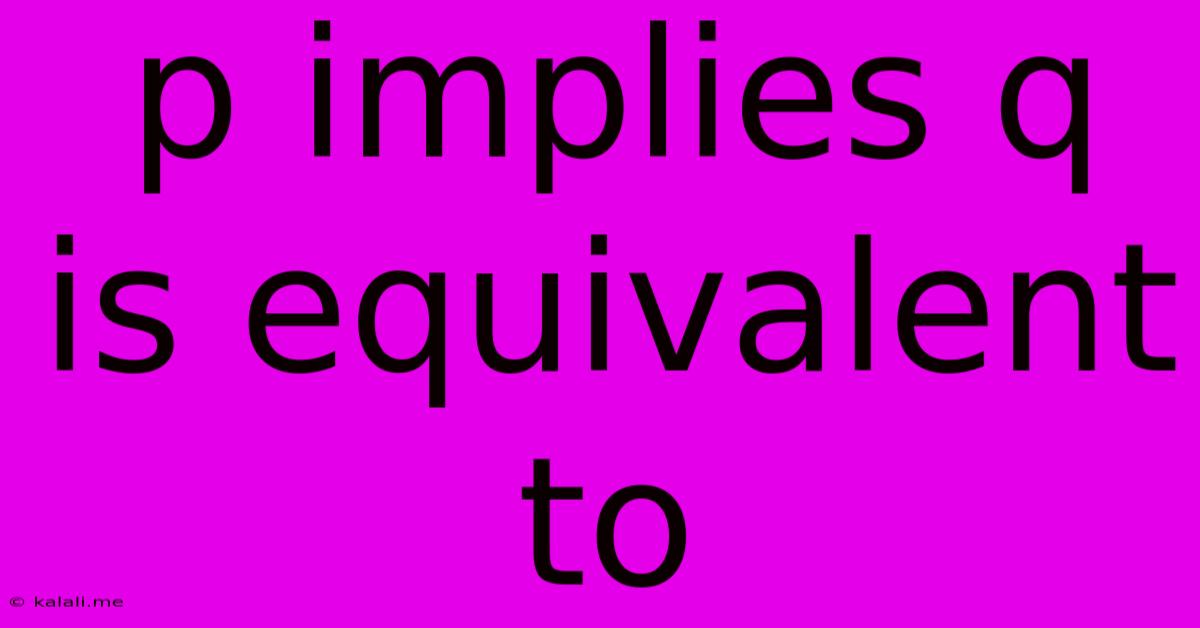P Implies Q Is Equivalent To
Kalali
May 30, 2025 · 3 min read

Table of Contents
P Implies Q: Understanding Logical Equivalence
This article explores the statement "P implies Q," a fundamental concept in logic, and delves into its various logical equivalences. Understanding these equivalences is crucial for anyone working with logic, mathematics, computer science, or any field requiring precise reasoning. We will examine how "P implies Q" can be expressed in different, yet logically identical, ways.
What does "P implies Q" mean?
In propositional logic, "P implies Q" (written as P → Q, or P ⊃ Q) means that if P is true, then Q must also be true. It's a conditional statement; the truth of P is a condition for the truth of Q. However, it doesn't say anything about the truth of Q if P is false. Let's look at the truth table:
| P | Q | P → Q |
|---|---|---|
| True | True | True |
| True | False | False |
| False | True | True |
| False | False | True |
The only time P → Q is false is when P is true and Q is false. This makes intuitive sense: if the condition (P) is met, but the consequence (Q) doesn't follow, the implication is false.
Logical Equivalences of P → Q
"P implies Q" has several logically equivalent statements. This means these statements have the same truth value under all possible assignments of truth values to P and Q. These equivalences are extremely useful for rewriting logical expressions and simplifying complex arguments. Here are some key equivalents:
1. ¬P ∨ Q (Not P or Q): The Disjunctive Normal Form
This is perhaps the most important equivalent. It states that "P implies Q" is logically equivalent to "either P is false, or Q is true (or both)." This equivalence is easily verifiable using a truth table, demonstrating identical truth values for both expressions across all possibilities. This form is crucial for understanding and manipulating Boolean algebra.
2. ¬(P ∧ ¬Q) (Not (P and not Q)): The Contrapositive
This reads as "it is not the case that both P is true and Q is false." This form highlights the only scenario where P → Q is false. It's useful for indirect proofs and demonstrating the validity of arguments. Understanding this equivalence is vital for mastering logical reasoning.
3. (P → Q) ≡ ¬P ∨ Q: A Direct Equivalence
This is a statement of the direct equivalence itself. It clearly states that the implication (P→Q) can be substituted with the disjunction (¬P∨Q) without changing the logical meaning. This forms the backbone of many logical manipulations.
Practical Applications
These equivalences are not just theoretical; they have practical applications in various fields:
- Computer Science: Boolean algebra, circuit design, and programming logic extensively rely on these equivalences for simplification and optimization.
- Mathematics: Proof techniques, particularly indirect proofs, often utilize the contrapositive form.
- Artificial Intelligence: Knowledge representation and reasoning systems use these equivalences for knowledge inference and decision-making.
Conclusion
Understanding the logical equivalences of "P implies Q" is essential for anyone working with formal logic. The ability to rewrite implications using disjunctions or negations provides powerful tools for simplifying complex logical expressions and constructing rigorous arguments. Mastering these equivalences strengthens logical reasoning skills and opens up a deeper understanding of logical structures. By recognizing these equivalent forms, one can effectively manipulate and analyze logical statements with increased accuracy and efficiency.
Latest Posts
Latest Posts
-
Does Jesus Have Holes In His Hand
May 31, 2025
-
How Do I Rethread A Bolt Hole
May 31, 2025
-
How To Install Dishwasher Under Granite Countertop
May 31, 2025
-
How Do Zombies Become Zombies In World War Z
May 31, 2025
-
What Happens If Your Car Runs Out Of Oil
May 31, 2025
Related Post
Thank you for visiting our website which covers about P Implies Q Is Equivalent To . We hope the information provided has been useful to you. Feel free to contact us if you have any questions or need further assistance. See you next time and don't miss to bookmark.